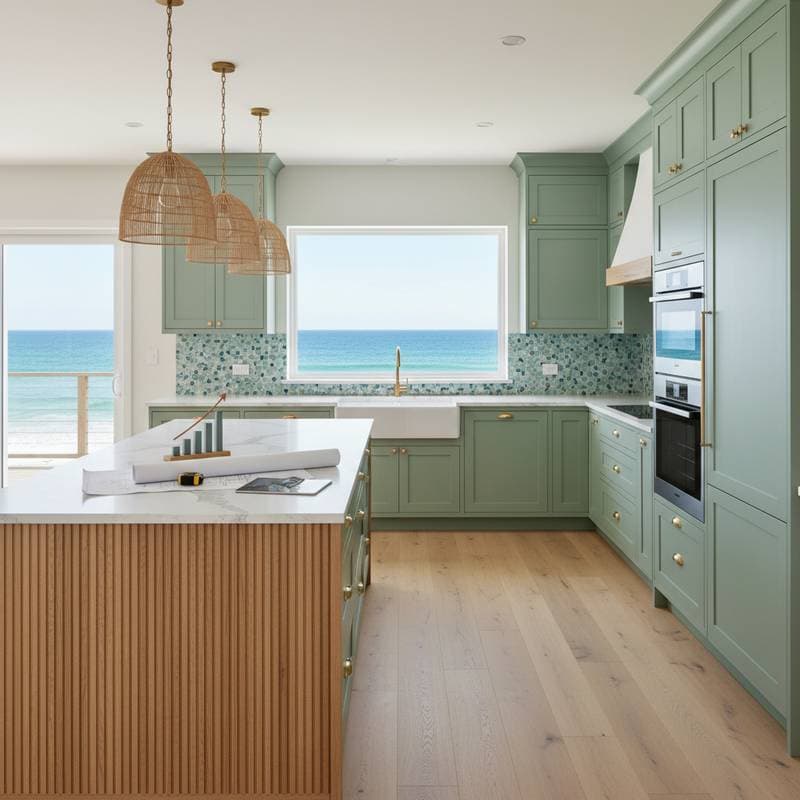What Your Coastal Kitchen Remodel Costs in 2025
A coastal kitchen remodel infuses the essence of seaside living into your home's core. Residents of waterfront properties or those seeking a relaxed, beach-inspired aesthetic benefit from such updates. Understanding costs for 2025 equips you to plan effectively. The average coastal kitchen remodel ranges from $32,000 to $115,000, with mid-range projects centering around $68,000. Variations arise from material selections, layout modifications, and customization extent.
This guide provides a thorough breakdown to establish a practical budget, select qualified professionals, and achieve a coastal kitchen that aligns with your daily routines and financial goals.
Cost by Kitchen Size
The size of your kitchen directly affects labor duration, material volume, and fixture numbers. The following table outlines typical costs by square footage for coastal remodels.
| Kitchen Size | Approximate Square Footage | Estimated Cost Range |
|---|---|---|
| Small Coastal Kitchen | 70 - 120 sq. ft. | $20,000 - $45,000 |
| Medium Coastal Kitchen | 130 - 250 sq. ft. | $50,000 - $85,000 |
| Large Coastal Kitchen | 260+ sq. ft. | $90,000 - $150,000+ |
Projects incorporating ocean views or extensions to outdoor decks incur extra expenses for framing and structural reinforcements, increasing totals by 10 to 20 percent.
Labor Costs in a Coastal Kitchen Remodel
Labor constitutes 25 to 40 percent of the overall budget in most remodels. In coastal regions such as San Diego, Miami, or the Carolina shores, rates tend to rise due to high demand and specialized handling of corrosion-prone materials.
| Trade | Typical Hourly Rate | Common Cost Estimate |
|---|---|---|
| General Contractor | $75 - $150 | $10,000 - $25,000 total |
| Cabinet Installer | $60 - $120 | $3,000 - $10,000 |
| Plumber | $80 - $160 | $1,500 - $4,000 |
| Electrician | $85 - $170 | $1,800 - $5,000 |
| Tile Setter or Flooring Installer | $50 - $100 | $2,500 - $8,000 |
| Painter or Finisher | $40 - $80 | $1,000 - $3,000 |
Proximity to the ocean necessitates additional preparations, including corrosion-resistant fasteners, marine-grade coatings, and vapor barriers to combat salt air and humidity.
How to Save Money on a Coastal Kitchen Remodel
Strategic planning allows you to manage expenses while preserving quality. Implement these approaches to optimize your investment.
- Refinish existing cabinets with marine-grade paint and updated hardware, achieving a refreshed appearance at a minimal fraction of replacement costs.
- Maintain current plumbing positions for sinks and dishwashers to eliminate extensive labor charges.
- Combine premium materials in prominent spots, such as the island countertop, with economical alternatives in less visible areas like upper cabinets.
- Schedule work during off-peak seasons, when contractors often provide discounted rates.
- Purchase appliances in bundled packages to secure savings of 10 to 20 percent.
- Install open shelving to cut cabinetry expenses and promote the light, open feel characteristic of coastal designs.
- Select energy-efficient options like LED fixtures and Energy Star-rated appliances to reduce future utility bills.
Common Mistakes to Avoid
Projects derail through overlooked elements, leading to budget overruns or delays. Steer clear of these frequent errors to ensure smooth execution.
- Neglect moisture safeguards; opt for humidity-rated materials and seal wooden elements thoroughly.
- Bypass required permits; coastal zones enforce rigorous codes for environmental and structural integrity.
- Underestimate electrical demands; contemporary kitchens require robust wiring for advanced lighting and appliances.
- Select inappropriate finishes; avoid glossy surfaces that highlight salt deposits and smudges.
- Overlook ventilation systems; install effective exhaust fans to mitigate humidity and safeguard cabinets.
- Pursue excessive customization; unique features may diminish future marketability.
- Omit a contingency reserve; allocate 10 to 15 percent of the budget for unforeseen expenses.
Frequently Asked Questions About Coastal Kitchen Remodels
Do I need a permit for a coastal kitchen remodel?
Most coastal remodels demand building permits, particularly those involving plumbing, electrical, or structural alterations. Waterfront properties often require additional reviews for environmental compliance and storm resilience.
How long does a coastal kitchen remodel take?
Construction on a standard coastal kitchen remodel spans 6 to 12 weeks. Cosmetic enhancements conclude more quickly, whereas extensive structural changes extend timelines based on permitting, inspections, and material availability.
What adds the most value to a coastal kitchen remodel?
Investments in superior cabinetry, resilient countertops, and efficient appliances yield the highest returns. An open configuration maximizing natural light and incorporating coastal motifs further enhances property appeal.
How can I design my coastal kitchen to resist humidity?
Incorporate quartz surfaces for countertops, porcelain tiles for floors, and marine-grade paints for walls. Integrate strong ventilation and rust-resistant hardware to defend against moisture and corrosion.
Are outdoor or open-air kitchen extensions worth the cost?
Such additions prove valuable for coastal dwellers, expanding livable areas via connections to decks or patios. Budget an extra 15 to 30 percent for durable, weather-resistant finishes and exterior appliances.
Can I use reclaimed wood in a coastal kitchen?
Reclaimed wood works well if properly sealed against moisture. Materials mimicking driftwood lend authentic charm, yet demand protection from swelling or distortion; consult contractors versed in coastal installations.
What is the best color palette for a coastal kitchen?
Embrace serene tones like soft whites, sandy beiges, and muted blues to evoke the ocean and shore. Accents in sea glass greens or weathered grays add depth, while natural wood elements provide warmth and balance.
Steps to Launch Your Coastal Remodel
Initiate your project with a defined budget and environment-specific design. Focus on moisture- and salt-tolerant materials, and secure expert installation for critical components like plumbing and wiring.
Obtain quotes from at least three licensed contractors experienced in coastal properties. Inquire about their strategies for ventilation, surface treatments, and ongoing upkeep.
Your completed coastal kitchen serves as a vibrant hub, merging seaside aesthetics with enduring functionality. Thoughtful preparation ensures a space that remains fresh and practical for years amid waterside living.

